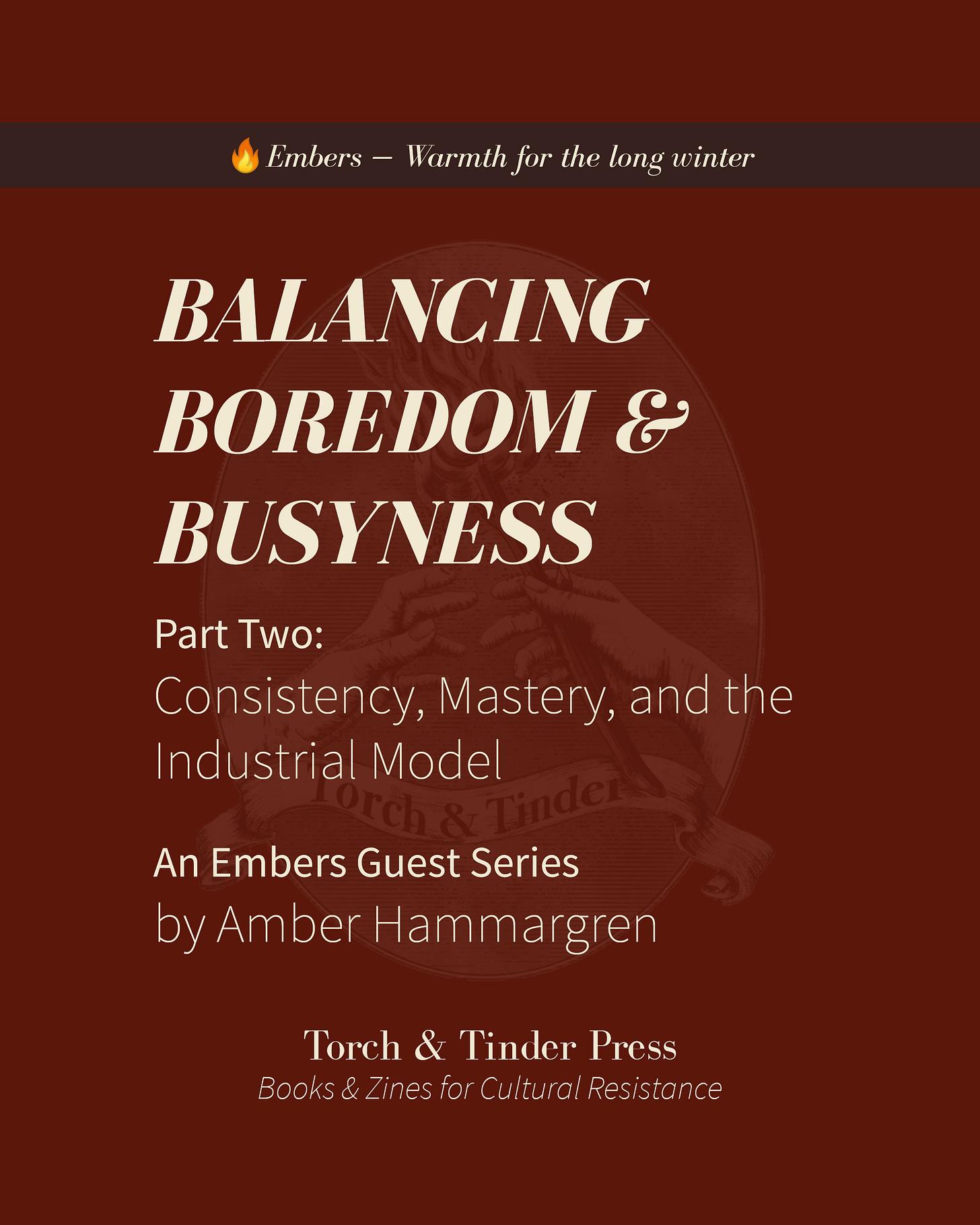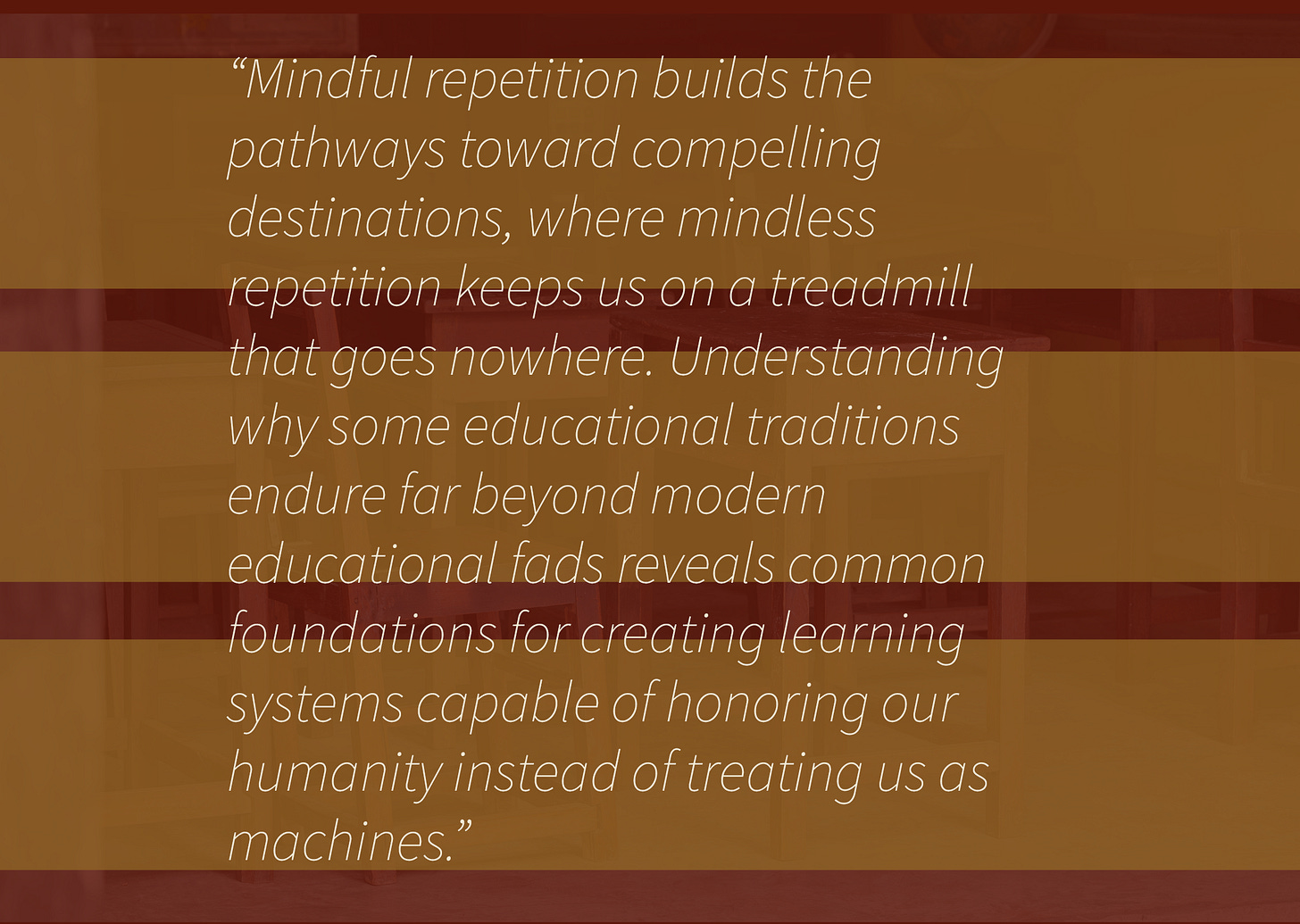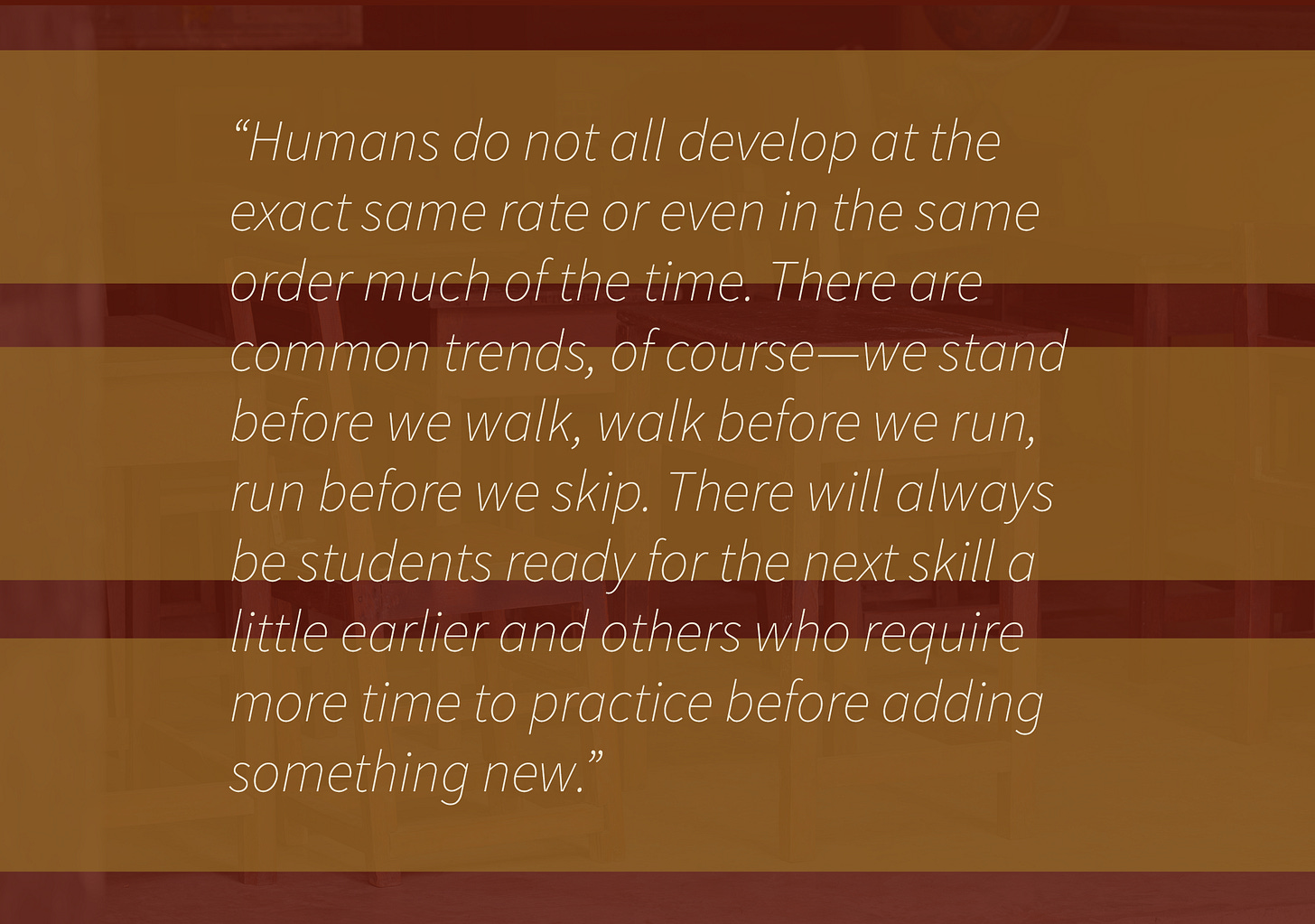Balancing Boredom & Busyness, Part 2: Consistency, Mastery, and the Industrial Model
Between the factory floor and the practice room lies a lesson: repetition can imprison or transform, depending on whether we remember we are human.
🔥 Embers — Warmth for the long winter
Every school system lives between two imperatives: speed and sameness. In this second essay from Balancing Boredom & Busyness, educator Amber Hammargren examines how industrial ideals of consistency can smother the slower, messier path to real mastery.
This essay is part of a three-part series by educator Amber Hammargren. Read Part One and subscribe to follow the series as it unfolds.
In a culture that pressures us to learn content that is easily reduced to data points measuring our efficiency, I wonder more about pursuits that endure. Throughout the world, there are many disciplines renowned for their tendency to develop a compelling mastery within their students. These are the traditions of education that hold my most rapt attention and fascination. I find it worth exploring what these all have in common, and one commonality that surprises me is this: these disciplines require notorious levels of repetition to achieve mastery and vast hours of dedicated study. When I have such an aversion to the sensation of being “stuck” in mindless repetition in my schooling, why have I not felt that same disgust when swimming laps, practicing musical instruments, studying martial arts, or learning handcrafts such as knitting and embroidery?
For all of them, I believe the answer comes in three parts. First, all the repetitions are not exactly repetitions at all—they are iterations that spiral deeper into mastery of the skill. Secondly, each of these pursuits provides neat little checkpoints for progress: a race time, a concert or recital, a belt test, a finished project to keep or give away. Sometimes those checkpoints have finite deadlines, sometimes they do not. Even when they do not, though, there is often a clear goal that defines the end of one step and the beginning of another. These checkpoints also provide excellent places to pause and take a break. There are places in the journey for rest, to breathe and to appreciate that you are not in the same place where you started, even when it sometimes feels like you are doing the same thing every day. Finally, the challenges they provide continue to grow with me, keeping the difficulty level in that Goldilocks zone of being neither too much (resulting in feeling lost, confused, or defeated) nor too little (resulting in feeling stuck, listless, bored, or aimless).
Mindful repetition builds the pathways toward compelling destinations, where mindless repetition keeps us on a treadmill that goes nowhere. Understanding why some educational traditions endure far beyond modern educational fads reveals common foundations for creating learning systems capable of honoring our humanity instead of treating us as machines. When we strive for mastery and integration of knowledge and skill into our complete being, we open the doors to deep levels of satisfaction in our learning, customized to each person’s life.
This brings us to the Capitalist-Industrialist version of consistency and how it plays out in education—especially public education. There is a very large difference between teaching for consistency and teaching for mastery. Teaching for mastery means helping each student own their skills to the highest level of competency and nuance they both want and need to be successful in life, to carry the lessons and knowledge they find most useful into their life adventures. The goal of consistency is simply that: sameness—for everyone to learn the same thing, at the same rate, at the same time, to the same depth, for the same applications, and to do the same tasks.
Public education is currently concerned not with mastery—although it gets sold as that—but with consistency. It is the Henry Ford assembly line approach, the mass-market process of educating young people, and the reduction of these young people to points of data in a series of graphs—trying to get them all to conform and produce the same product, at the same quality, by the same time, at every step of the process. While I absolutely advocate for assessing quality of instruction and accountability in education, the current obsession with standardized testing data and fretting about whether a student will keep up with arbitrary targets set by state legislators—I do not support that mindset at all.
As for my idea of what accountability in education should look like, well, that would be a different essay altogether. For now, let’s address the concepts of consistency and mastery. In many districts throughout my own state of Texas, throughout the United States, and even in many schools abroad, there is a movement toward scripted lessons and curricula for as many courses as possible. While government agencies provide many justifications for this loss of autonomy and professional respect for the role of the teacher, one of the supposed benefits to these scripted courses is to ensure consistency—consistency of materials used, vetted and approved by school boards and district officials as “high-quality instructional materials” that are also unlikely to cause parents discomfort or offense. Consistency of delivery of content in terms of both the strategies and activities used, and the pacing.
What none of this actually delivers, however, is consistency of students mastering the concepts and skills presented to them. Teachers are told to deliver scripted lessons with total fidelity, but also to differentiate for the various learners in their rooms. These are contradictory mandates. No matter how much we attempt to control variables from classroom to classroom, one reality remains that will prevent the complete mechanistic fantasy of uniform academic achievement at each step: we are not machines; we are human.
Humans do not all develop at the exact same rate or even in the same order much of the time. There are common trends, of course—we stand before we walk, walk before we run, run before we skip. There will always be students ready for the next skill a little earlier and others who require more time to practice before adding something new. There will be students fascinated by a particular topic before it’s ever introduced, and others who have never heard of it until a teacher brings it to their attention. Accepting that we are teaching individual human beings, not machines, is essential for any learning environment that seeks for each of the learners to thrive.
For all the incredible discoveries and methods we’ve brought to education through the industrialist mindset, taking it to the extreme not only exposes the limitations of this approach but also reveals the harms it creates. For students who seek additional challenges, who make unusual connections across content, or who simply discover material in a different order than presented by these scripts, being held to a common pacing in the classroom can feel akin to being a tiger in a circus cage—trapped and forced away from the environments and activities where it thrives. For students who need additional time to process and integrate each new piece of learning into their complete skill set, being held to that same pacing can feel like a forced march in ill-fitting boots—an endurance test of unnecessary pain and distraction.
Back to the things that held my attention for the long haul, and how the traditions of learning within these studies differ from the Capitalist-Industrialist approach of sameness. On swim team, I trained with a variety of ages and skill levels alongside me, and our workouts were scaffolded to allow those with more speed and skill to continue being challenged while allowing those who were younger, slower, or less knowledgeable to grow from their current level without pressure to already be farther ahead. Additionally, a culture of peer mentorship flourished, where we were encouraged to share techniques with those less experienced as we grew in skill and age.
I found a similar environment when I began Tae Kwon Do as an adult. Your place in your journey is what it is; you are where you are, and you grow at the rate that you grow. It doesn’t matter whether you begin at eight or at thirty-seven. Whenever you begin, and in whatever physical state you arrive, there is no shame in not having begun earlier or in not having arrived prepared. You do not train to prepare for your white belt—everyone is allowed to be a true novice upon beginning. It is acknowledged within these fields that a participant’s rate of growth is directly related to their personal efforts to practice and seek improvement; it is a collaboration between the teacher or coach, the more experienced students who mentor and act as role models, and each participant.
What practice, art, or craft has taught you the most about patience and pace?
In music education classrooms, while it is common for directors and teachers to push aggressively for students to progress in their skills, there is a similar acknowledgment that they often arrive without prior knowledge or experience, and they will all grow at their own pace. I will not say there is no stigma for those who progress more slowly in music education—I have known far too many people who felt pushed out of those spaces and made to feel they could not succeed in their pursuit of musicianship because their progress was not as swift as others’. Nevertheless, there is an acceptance that keeping all students in lockstep with one another is not just impossible—but even if it were possible, would be undesirable.
Such rigidity would prevent many students from attaining excellence—to be held back from going faster when they are capable. I find the goal of complete consistency of pacing similarly undesirable for those whose musicianship comes only through struggle and great effort to make even minimal gains. If the goal is for students to remain fully engaged in the art and discipline of music making—and to participate in this very human birthright that knits together culture and community—then implementing a pace that teaches so many students they do not belong, that they are not musical creatures, is not just counterproductive but actively harmful.
If this reflection resonates, share it with someone who’s still trying to rush their way to mastery. We learn better together.
Instead, I draw from the wisdom of my college clarinet professor, Dr. James Gillespie. The most influential thing I ever learned about growth, musical and otherwise, came from a frustrating day in my weekly lessons. Dr. Gillespie was known for holding exceptionally high standards, and though I had clearly worked diligently that week, I still fumbled through the materials he asked me to prepare. Noticing that I was upset with myself for failing to achieve the goals for that week, he told me, “Sometimes growth comes in miles, and that always makes us feel good. But sometimes growth comes in millimeters, and that is harder to see. Both are worthy of recognition. All growth is good. Just don’t go backwards if you can help it.”
His words have guided me through many frustrating situations ever since, and I pass them on to my own students when they need to hear them. It helps that in all these disciplines, there is no government edict declaring that both the students and teachers are failing horribly and in need of intervention to get them “back on track” or else risk dire consequences and be seen as defective. There is such a difference between being encouraged to grow and being coerced to grow by a certain amount in a certain time.
The disciplines that have held my fascination emphasize that practicing toward mastery is a lifelong pursuit without an endpoint. You do not reach the pinnacle of perfection or an end to what there is to learn and practice. There is no rush, because you have your entire life to continue growing into mastery, if that is your desire. You may grow in miles, and you may grow in millimeters—both are worthy of recognition.
About Amber
Amber Hammargren has taught music in private lessons and public school classrooms for more than twenty years. She is a proud graduate of the University of North Texas (Music Education) and the University of Texas at San Antonio (Educational Leadership, Urban School Leadership Collaborative). She is also the founder of Ember Commons; a grassroots school rooted in community and creativity. Amber enjoys reading, making music, camping, and many kinds of crafts.
This is Part Two of our three-part Embers series, Balancing Boredom & Busyness.
Subscribe to stay in the loop. New essays release every Wednesday.
Explore more from Torch & Tinder Press
📣 Signal Dispatch — Signals from the field
🔧 Torchlight Praxis — Tools you can carry
🔥 Embers — Warmth for the long winter (you’re here)
Stay connected: Instagram · Bluesky · Facebook
One-Time Support & community editions: Ko-fi
Support the work:
Subscribe free on Substack to receive every post.
Become a Paid Subscriber ($8/month or $80/year) to help fund print releases and join Refuge Bonne Foi.
Join as a Torchbearer ($240/year) for early access to Core Collections and digital issues.
Group discounts: 20% per seat (min. 3).
Prefer a one-time gift? Support us on Ko-fi.






